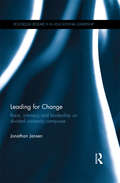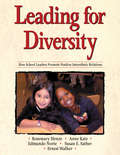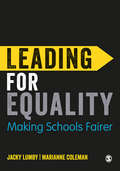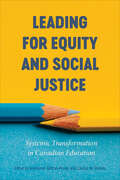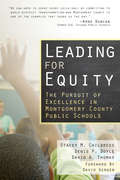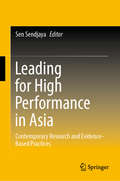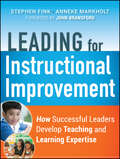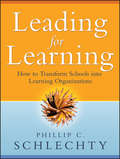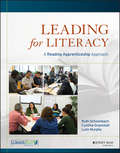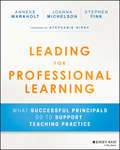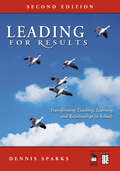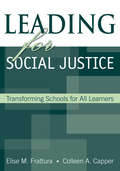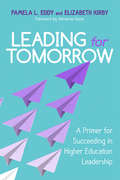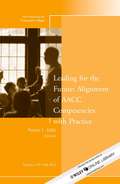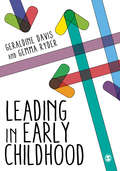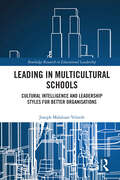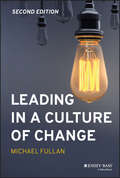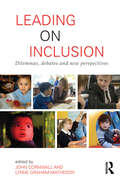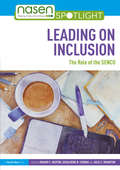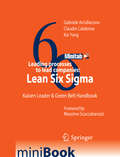- Table View
- List View
Leading for Change: Race, intimacy and leadership on divided university campuses (Routledge Research in Educational Leadership)
by Jonathan JansenThis book offers new theoretical ground for thinking about, and transforming, leadership and higher education worldwide. Through an examination of the construct of intimacy and ‘nearness’, including emotional, spiritual, psychic, intellectual, and physical closeness, Jonathan Jansen demonstrates its power to influence positive leadership in young people. He argues that sensory leadership, which includes but extends beyond the power of touch, represents a fresh and effective approach to progressive transformation of long divided institutions. Considering richly textured narratives, chapters explore complex intimacies among Black and White university students in South Africa, post-apartheid and in the aftermath of a major racial atrocity. The stories reveal the students’ transformation in the process of ‘leadership for change’, interweaving concepts of racism, human relationships and intimacy, and in turn expanding the knowledge base of social and institutional improvement. This book explores how, when different kinds of nearness come together in leadership change, young people respond in ways that would not be possible through conventional instruments such as policy, legislation and the appeal to moral sensibilities alone. Leading for Change will be critical reading for academics, researchers and postgraduate students in the fields of education, educational justice, higher education, educational leadership and change, social and/or racial justice. This book will also be of interest to those working in the fields of anthropology, social psychology, and South African contemporary politics, policy and institutional practices.
Leading for Diversity: How School Leaders Promote Positive Interethnic Relations
by Rosemary C. Henze Dr Susan E. Sather Mr Edmundo Norte Ernest Walker Dr Anne KatzThe authors provide powerful models of leadership that are effective in developing schools where positive interethnic relations can flourish.
Leading for Equality: Making Schools Fairer
by Dr Marianne Coleman Professor Jacky LumbyDisentangling the concept of equality in schools can be a tricky task for those in senior, middle or classroom leadership. This book will unpack ideas of equality, equity, diversity and social justice, providing practitioners and those training to teach with an understanding of equality in order to address educational values and practice. Drawing on a wide range of case studies from schools in England, Wales and Scotland, the authors illustrate the importance of leading for equality with a clear and proactive vision for change. The authors explore these key areas: · Socio-economic class · Gender · Sexuality · Ethnicity · Religion · Migrant children · Special learning needs and disabilities This book will serve as a handy guide for postgraduate and undergraduate students on Education Leadership and Inclusive Education courses.
Leading for Equality: Making Schools Fairer
by Professor Jacky Lumby Marianne ColemanDisentangling the concept of equality in schools can be a tricky task for those in senior, middle or classroom leadership. This book will unpack ideas of equality, equity, diversity and social justice, providing practitioners and those training to teach with an understanding of equality in order to address educational values and practice. Drawing on a wide range of case studies from schools in England, Wales and Scotland, the authors illustrate the importance of leading for equality with a clear and proactive vision for change. The authors explore these key areas: Socio-economic class Gender Sexuality Ethnicity Religion Migrant children Special learning needs and disabilities This book will serve as a handy guide for postgraduate and undergraduate students on Education Leadership and Inclusive Education courses.
Leading for Equity and Social Justice: Systemic Transformation in Canadian Education
by Carolyn M. Shields Andréanne Gélinas-ProulxEducational institutions, and in particular educational leaders, play critical roles in identifying and rectifying the many inequities that oppress, marginalize, and exclude individual students, educational actors, and some minoritized groups in Canadian education. Leading for Equity and Social Justice provides a deep look at some of these inequities and injustices and offers transformative leadership as one way for leaders to stimulate, support, and foster equitable and socially just practices in educational institutions. This collection emphasizes the systemic nature of inequality and supports the necessity of systemic change to target not only individuals but also structures, policies, and far-reaching practices. Focusing on various marginalized groups – including the Indigenous community, LGBTQ2S+ peoples, refugees, newcomers, and specific groups of teachers – chapters explore transformative leadership in practice and how to achieve inclusion, respect, and excellence in schools. Arguing that leadership involves much more than simply putting policy into practice, Leading for Equity and Social Justice promotes the need for leaders to recognize their role as advocates and activists.
Leading for Equity: The Pursuit of Excellence in the Montgomery County Public Schools
by David Gergen David A. Thomas Stacey M. Childress Denis P. DoyleLeading for Equity tells the compelling story of the Montgomery County (Maryland) Public Schools and its transformation--in less than a decade--into a system committed to breaking the links between race and class and academic achievement. In chapters organized around six core themes, the authors lay out the essential elements of MCPS's success. They identify key lessons other districts can draw from MCPS's experience and offer a framework for applying them. A dramatic departure from "business as usual," MCPS has won nationwide attention as a compelling model for tackling the achievement and opportunity issues that confront our nation as a whole.
Leading for Equity: The Pursuit of Excellence in the Montgomery County Public Schools
by David A. Thomas Stacey M. Childress Denis P. DoyleLeading for Equity tells the compelling story of the Montgomery County (Maryland) Public Schools and its transformation—in less than a decade—into a system committed to breaking the links between race and class and academic achievement. In chapters organized around six core themes, the authors lay out the essential elements of MCPS&’s success. They identify key lessons other districts can draw from MCPS&’s experience and offer a framework for applying them. A dramatic departure from &“business as usual,&” MCPS has won nationwide attention as a compelling model for tackling the achievement and opportunity issues that confront our nation as a whole.
Leading for High Performance in Asia: Contemporary Research and Evidence-Based Practices
by Sen SendjayaHow do leaders lead for high performance in Asia, the fastest growing region in the world? What are the new leadership influential processes and skillsets needed to engage the organizational members in creative and meaningful ways? In this book, readers will find strategic insights and tips derived from cutting-edge studies on specific leadership and management issues in Asia. Using a range of methodologies from in-depth interviews, field surveys, and computer simulation, the studies include the following topics: Strategies to foster citizenship and pro-social behaviors in high-performing firms; the roles of culture-specific values such as paternalism and collectivism, the construction of leader identity, the effects of leadership on team satisfaction, the development of female leaders, and key lessons in strategic leadership development. Featuring studies conducted in China, Indonesia, Singapore, and Australia, this book will equip readers with a set of strategic and actionable tools for tackling the leadership challenges in Asia. Further, each chapter includes a ‘Managerial Implications’ section, in which subject experts share evidence-based practical and contextual recommendations.
Leading for Instructional Improvement
by Stephen Fink Anneke MarkholtThere is little agreement among school leaders on what constitutes quality teaching and how best to support teachers in improving lessons, assessments, and classroom instruction. This book will show how principals and other school leaders can 'grow' the expertise of teachers to deliver high quality instruction that serves all students well. It introduces principals to a five-part model of effective instruction. It then shows leaders how to make use of this framework for guiding new and veteran teachers on improving lessons, instruction, and other aspects of classroom practices.
Leading for Learning
by Phillip C. SchlechtyWritten by acclaimed school reform advocate Phillip C. Schlechty, Leading for Learning offers educators the framework, tools, and processes they need to transform their schools from bureaucracies into dynamic learning organizations. Schlechty explains how to move beyond some of the deeply ingrained and negative conceptions of schooling that guide so much of their practice. He shows educators how they can take advantage of new learning technologies by increasing their organization's capacity to support continuous innovation."Clearly not for the fainthearted, Schlechty's engrossing appraisal of American education calls for a bold, truly fundamental transformation of how we run our public schools. Some books are thought-provoking; this one is action-provoking." -W. James Popham, professor emeritus, UCLA"Dr. Schlechty has once again written an insightful book that educational leaders can use as a road map in transforming our schools into learning organizations designed to serve twenty-first century students." -Dr. Randy Bridges, superintendent, Alamance-Burlington School System, NC"Because education is ultimately a community responsibility, Schlechty's proposal to shift school systems from bureaucracies to learning organizations can open doors to citizens who are frustrated by the bureaucracy in their efforts to reclaim their role in education. This book is as much for them as it is for professional educators." -David Mathews, president, Kettering Foundation"Anyone in a school leadership position-from the board room to the classroom-should read this engaging and thought-provoking book. It's a must?-read for all immersed in or contemplating the transformation of public education." - Claudia Mansfield Sutton, chief communications and marketing officer, American Association of School Administrators
Leading for Literacy: A Reading Apprenticeship Approach
by Ruth Schoenbach Cynthia Greenleaf Lynn MurphyClear, on-the-ground guidance for Reading Apprenticeship implementation Leading for Literacy provides tools and real-life examples to expand the benefits of a literacy approach that sparks students' engaged reading and thinking across disciplines, from middle school through community college. A companion to the landmark Reading for Understanding, this book guides teachers, leaders, and administrators through the nuts, bolts, benefits, and stumbling blocks of creating Reading Apprenticeship communities that extend a culture of literacy beyond individual classrooms. This book explains how to generate authentic buy-in from teachers and administrators, use the Reading Apprenticeship Framework to turn reform overload into reform coherence, and create literacy teams, professional learning communities, and Reading Apprenticeship communities of practice that sustain an institutional focus on a student-centered, strengths-based culture of literacy. Key insights from Reading Apprenticeship practitioners across the country address how to get started, build momentum, assess progress, and build partnerships and networks across schools, districts, campuses, and regions. Persistently low levels of adolescent literacy continue to short-change students, contribute to discredited high school diplomas, and cause millions of students to drop out of high school and community college. Forty percent or more of community college students require remedial reading courses as college freshman. The researchers at WestEd's Strategic Literacy Initiative developed the Reading Apprenticeship Framework to provide educators with a proven path to improving literacy for all students, and this book provides clear guidance on bringing the framework to life. How to integrate Reading Apprenticeship with existing reform efforts How to use formative assessment to promote teacher and student growth How to coach and empower teachers How to cultivate literacy leadership How to provide long-term support for a strong content-literacy program Nationwide classroom testing has shown Reading Apprenticeship to promote not only literacy and content knowledge, but also motivation and positive academic identity--leading to better student outcomes that reach beyond the classroom walls. Leading for Literacy lays out compelling ways to spread the benefits of Reading Apprenticeship, with practical guidance and real-world insight.
Leading for Professional Learning: What Successful Principals Do to Support Teaching Practice
by Stephen Fink Anneke Markholt Joanna MichelsonSupport teachers with more effective instructional leadership Leading for Professional Learning offers field-tested guidance to help school leaders more effectively support teachers’ professional development. Leadership is crucial to professional learning, providing the necessary systems and structures that enable teachers to improve their own practice and in turn, improve student learning. With an illustrative case study, this book provides invaluable guidance, packed with practical tools, processes, and expert advice. Because each school differs in terms of strengths and needs, this book steers away from prescriptivism and shows you how to construct a support plan tailored to your unique context. Specific teaching and leadership frameworks guide you through the process of examination, discovery, and execution, equipping you with the necessary tools and insight you need to make positive changes for your teachers – and ultimately, your students. A must-read resource for principals, administrators, and other school and district leadership, this book helps you set your school on the path to continuous improvement. Determine your school’s professional learning needs Leverage existing support structures for the greatest effect Understand the role of leadership in sponsoring and following up on professional learning Ensure intentional changes in teacher practice and student learning Empowering teachers to improve their craft goes beyond merely offering opportunity; it requires collaboration with teachers every step of the way, a deep understanding of how best to support professional learning, a clear set of goals for both individual sessions and an overarching mission, and the necessary technical and relational support required to see these opportunities through. Written by experts from the University of Washington Center for Educational Leadership, Leading for Professional Learning provides real-world advice that has been proven effective in school districts across the nation.
Leading for Results: Transforming Teaching, Learning, and Relationships in Schools
by Dennis SparksFeaturing 18 new essays, this second edition shows how school leaders can promote extraordinary changes, be accountable, and achieve meaningful results for schools, districts, and their personal lives.
Leading for Social Justice: Transforming Schools for All Learners
by Elise M. Frattura Colleen A. CapperA step-by-step process for raising the achievement of English language learners and students with special needs and for integrating schoolwide change through proactive support services that benefit all students.
Leading for Tomorrow: A Primer for Succeeding in Higher Education Leadership
by Pamela L. Eddy Elizabeth KirbyWhen faculty climb the ranks into leadership positions, they come with years of knowledge and experience, yet they are often blindsided by the delicate interpersonal situations and political minefields they must now navigate as university administrators. What are the specific skills that faculty need to acquire when they move into administrative positions, and how can they build upon their existing abilities to excel in these roles? What skills can other mid-level leaders learn to help in their positions? Using an engaging case study approach, Leading for Tomorrow provides readers with real-world examples that will help them reflect on their own management and communication styles. It also shows newly minted administrators how they can follow best practices while still developing a style of leadership that is authentic and uniquely their own. The book’s case studies offer practical solutions for how to deal with emerging trends and persistent problems in the field of higher education, from decreasing state funding to political controversies on campus. Leading for Tomorrow gives readers the tools they need to get the best out of their team, manage conflicts, support student success, and instill a campus culture of innovation that will meet tomorrow’s challenges.
Leading for the Future: New Directions for Community College, Number 159 (J-B CC Single Issue Community Colleges #231)
by Pamela L. EddyThe AACC competencies were initially developed to help provide guidance in developing community college leaders because of predictions of a leadership crisis in the two-year college sector. Since their creation, the competencies have been used to direct topics in leadership development programs and to guide future leaders about what skills are critical to master. Yet scant research exists on the use of the competencies in practice or on analysis of the competencies within the changing higher education climate. This issue provides a review of the research on the competencies in the field and posits several strategies for the future use of the competencies and potential changes to the competencies. This is the 159th volume of this Jossey-Bass quarterly report series. Essential to the professional libraries of presidents, vice presidents, deans, and other leaders in today's open-door institutions, New Directions for Community Colleges provides expert guidance in meeting the challenges of their distinctive and expanding educational mission.
Leading from Here to There Study Guide
by Bill HybelsBestselling author and pastor Bill Hybels helps equip leaders with five key skills that everyone needs in order to grow their leadership ability. Each of the video sessions will feature Hybels sharing the wisdom and experience that he has learned in nearly 40 years of leadership at Willow Creek Community Church in South Barrington, Illinois.In this five-session teaching video (DVD/digital video sold separately), Hybels will help leaders discover what kind of leader they are, how to gain self-awareness and relational awareness, how to build an effective team, how to form and declare a vision, and discovering each leader's holy discontent.Sessions include:The Power of VisionThe Toughest Person You LeadMastering 360-Degree LeadershipBuilding a Fantastic CulturePursue Your Unique CallingDesigned for use with the Leading from Here to There Video Study 9780310884606 (sold separately).
Leading in Early Childhood
by Geraldine Davis Gemma RyderLeadership in the early years is about using your knowledge, skills, personality and experience to positively influence practice. Every practitioner has the capacity to lead, and in doing so, improve opportunities for children and their families. Examining the various roles of early years practitioners, and the everyday challenges and opportunities they face, this book promotes leadership of early childhood practice by considering the following; · Who the leaders are, and what skills they require, · The variety of ways a practitioner can lead within a setting, · Key roles including the team leader and the key person, · How to develop a culture of leadership, · The importance of working with families and other professionals, · Improving leading through reflective practice. Whether you are a room leader in an early childhood setting needing support in your leadership skills, a manager of an early childhood business, a leader of a nursery, a leader of practice or studying to become an early years practitioner this book is ideal for helping you improve your leadership skills.
Leading in Early Childhood
by Geraldine Davis Gemma Ryder<P>Leadership in the early years is about using your knowledge, skills, personality and experience to positively influence practice. Every practitioner has the capacity to lead, and in doing so, improve opportunities for children and their families. <P>Examining the various roles of early years practitioners, and the everyday challenges and opportunities they face, this book promotes leadership of early childhood practice by considering the following; <P>· Who the leaders are, and what skills they require <P>· The variety of ways a practitioner can lead within a setting <P>· Key roles including the team leader and the key person <P>· How to develop a culture of leadership <P>· The importance of working with families and other professionals <P>· Improving leading through reflective practice. <P>Whether you are a room leader in an early childhood setting needing support in your leadership skills, a manager of an early childhood business, a leader of a nursery, a leader of practice or studying to become an early years practitioner this book is ideal for helping you improve your leadership skills.
Leading in Multicultural Schools: Cultural Intelligence and Leadership Styles for Better Organisations (Routledge Research in Educational Leadership)
by Joseph Malaluan VelardeVelarde explores how cultural competencies and leadership styles can be integrated and maximised to create and sustain a healthy environment for better learning. The integration of cultural intelligence and effective school leadership practices shapes the foundation for a culturally strategic leadership. This book uses research from Malaysia supported by cases and studies from various parts of the world to bring readers perspectives that can be applied in an international context. Velarde examines how various school leaders (i.e., principals, coordinators, heads of department, teacher leaders) in national and international schools utilise cross-cultural capabilities and leadership styles in their multicultural schools to work inclusively on a shared vision despite the challenges of cultural conflicts. As a framework in leading in multicultural schools, its culturally strategic leadership principles and practices come from the examination of current research in cultural intelligence and educational leadership to provide scholars and practitioners an alternative perspective and practical guide in school leadership and its intended outcomes. This insightful, practical, and reflective guide will be useful as a reference for scholars and students in the field of educational leadership and management. As a supplement to teaching modules in universities, lecturers of school leadership will also find this book resourceful.
Leading in a Culture of Change
by Michael FullanThe new edition of the best-selling guide for powerful, morally-grounded change leadership in any organization. Change is an inevitable, essential part of the modern world. Change prevents stagnation, fosters creative solutions, and propels innovation. With change comes challenges: to survive and prosper, organizations need to adapt to shifting market dynamics, volatility in the public arena, disruptions brought on by new technologies, and many more. Leaders need to understand the dynamics of change to cope with the complexities of the change process. Leading in a Culture of Change describes the key dimensions of leadership that are crucial in times of change. This innovative guide helps readers master the five components of change leadership—moral purpose, understanding change, building relationships, creating and sharing knowledge, and creating coherence—and mobilize others to accomplish shared goals in often difficult conditions. Extensively revised and updated throughout, this market-leading book continues to help leaders from across sectors understand the dynamics of change and navigate the end-to-end change process. The second edition is now thoroughly grounded in the various forms and interpretations of successful change and includes more precise definitions of the core competencies of change, contemporary case studies of their development and practical application, and increased guidance on their effective use through new concrete examples. Combining knowledge from the worlds of education and business, this unique book will help you: Integrate proven, time-tested methods of education reform and the most current insights in leadership and organizational change Develop and implement positive, sustained systematic change strategies in any organization Increase performance, optimize learning, and improve leadership Understand the key principles of leading change through specific, real-world examples Embrace a morally-grounded process of effective organizational change Leading in a Culture of Change is an indispensable source of information for leaders in business, non-profit, and public sectors seeking to understand, influence, and lead the change process.
Leading on Inclusion: Dilemmas, debates and new perspectives
by Lynne Graham-Matheson John CornwallLeading on Inclusion: Dilemmas, debates and new perspectives critically examines the current theory and legislative context of special educational needs and disability, and explores the enduring issues and opportunities that will affect future practice in all schools. The central theme throughout the book asks the inevitable question ‘What happens next?’ and the expert team of contributors, drawn from a pool of teachers, academics and researchers, consider wide-ranging issues such as: the voice of young people whole school development and planning for inclusion educational change within the context of inclusion the pros and cons of multi-professional working inclusive and ethical research international perspectives on inclusion, SEN and disability the development of teacher education and the notion of ‘joined up’ thinking. This forward-thinking and rigorously researched book will be essential reading for students, teachers undertaking school-based training, SENCOs, inclusion managers, higher education tutors and anyone with a professional interest in the future for inclusive education.
Leading on Inclusion: The Role of the SENCO (nasen spotlight)
by Mhairi C. Beaton; Geraldene N. Codina; Julie C. WhartonThis comprehensive resource provides a range of perspectives on inclusion, giving Special Educational Needs Co-ordinators (SENCOs) the opportunity to consider the principles and practice that underpin their leadership role. Offering a blend of academic and professional knowledge, each chapter explores different aspects of the role of the SENCO and supports areas that will be considered as part of the National Award for SENCOs. A variety of essential topics are covered, from the importance of SEND provision and multi-disciplinary practice, to the role of the SENCO and leadership. Key features of this book include: Contributions by leaders of the National Award for Special Educational Needs Co-ordinators working with trainee SENCOs across the country A focus on encouraging SENCOs to think deeply about their own individual practice through engagement with cutting-edge research A flexible structure that can be read as a whole, or dipped in and out of as professional learning needs require This book provides an opportunity for readers to engage with a multiplicity of voices and approaches, allowing them to critically explore their role as leaders of SEND provision in schools. It is an invaluable resource both for students and those already within the role of Special Educational Needs Co-ordinator.
Leading processes to lead companies: Kaizen Leader & Green Belt Handbook
by Claudio Calabrese Gabriele Arcidiacono Kai YangThis Minibook is a brief guide for Green Belt during a Lean Six Sigma project management or for Kaizen Leader during a process improvement activity. Through both its theoretical concepts and practical examples it is a pocket book for a quick consultancy. Authors idea comes from companies needs in order to analyze information useful to know in depth different kind of processes. The set of Six Sigma tools are explained through Minitab 16, the last release of the most widely used statistical software.
Leading research universities in a competitive world
by Robert LacroixAlthough research universities represent only fifteen to twenty per cent of national university systems worldwide, they provide the bulk of fundamental research and doctoral training. Written by two veteran university administrators, Leading Research Universities in a Competitive World focuses on the international ranking systems’ uneven distribution of these institutions in industrialized countries, and the organizational factors affecting their efficacy, prestige, and performance. Robert Lacroix and Louis Maheu argue that research universities, despite being embedded within academia’s mindset and rules, have to master market influences and relationships in order to produce new knowledge and attract the rare talent and limited financial assets required for successful research and education activities. Comparing the configuration of higher education systems in the US, UK, France, and Canada, the authors outline the ways in which research universities, which need public funding and have to engage diverse forms of state regulation, may possess sufficient autonomy to behave as independent actors. They demonstrate that reaching an equilibrium between autonomy and state regulation, though challenging, is an essential element in the success of high performing research universities. Leading Research Universities in a Competitive World illuminates the operation of these institutions through substantive quantitative and qualitative datasets to address the fundamental question of why universities perform differently.
